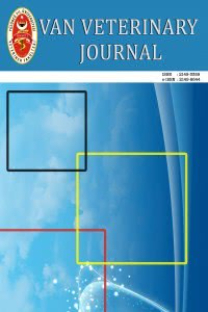Possible epidemiological role of dogs in carrying infectious bursal disease virus (IBDV) to poultry
enfeksiyöz bursal hastalık virüsü, hastalık yaygınlığı, epidemiyoloji, kümes hayvanları, reservuar konukcuları, köpek, civciv embriyoları, sitopatojenite, hastalık tetkiki, hastalık bulaşması, genom
İnfeksiyöz bursal hastalık virusunun (IBDV) kanatlılara taşınmasında köpeklerin muhtemel rolü
infectious bursal disease virus, disease prevalence, epidemiology, poultry, reservoir hosts, dogs, chick embryos, cytopathogenicity, disease surveys, disease transmission, genomes,
___
- Lee LH, Ting IJ, Shien JH, Shieh HK (1994). Single-tube, non-interrupted reverse transcriptase-PCR for the detection of infectious bursal disease virus. J Clin Microbiol, 32(5), 1268-1272.
- Lukert PD, Saif YM (2003). Infectious bursal disease. In: Diseases of Poultry, 11th edn. Eds Y. M. Saif. Iowa State University Press, Ames, Iowa, USA, pp 161-179.
- Pages-Mante A, Torrents D, Meldonado J, Saubi N (2004). Dogs as potential carriers of infectious bursal disease virus. Avian Pathol, 33(2), 205-209.
- Park MJ, Park JH, Kwon HM (2010). Mice as potential carriers of infectious bursal disease virus in chickens. Vet J, 183 (3), 352-354
- Rosenberger JK, Saif YM, Jackwood DJ (1998). Infectious bursal disease. In: A laboratory manual for the isolation and identification of avian pathogens. 4th edn. Eds D. E. Swayne, J. R. Glisson, M. W. Jackwood, J. E. Pearson, W. M. Reed. American Association of Avian Pathologists, Kennett Square, PA, pp 215-219. Smiley JR, Jackwood DJ (2001). Genetic stability of the VP2 hypervariable region of four infectious bursal disease virus isolates after serial passages in specific pathogen free chicken embryos. Avian Dis, 45, 1-8.
- Yamaguchi T, Setiyono A, Kobayashi M, Takigami S, Fukushi H, Hirai K (2000). Infectious bursal disease live vaccines: changes in the virus population during serial passage in chickens and chicken embryo fibroblasts cells. Avian Dis, 44, 284-290
- Zahoor MA, Hussain I, Khan QM (2005). Two outbreaks of very virulent infectious bursal disease virus in Pakistan. Vet Rec, 157, 813-814.
- ISSN: 1017-8422
- Yayın Aralığı: 3
- Başlangıç: 1990
- Yayıncı: Yüzüncü Yıl Üniv. Veteriner Fak.
A new curative approach to puppy vaginitis
Mehmet UÇAR, Cenker Çağrı CINGI, TURAN CİVELEK
Puppy vaginitis’e yeni bir sağaltım yaklaşımı
Turan CİVELEK, Cenker Çağrı ÇİNGİ, Mehmet UÇAR
Taraneh ÖNCEL, Ender GÜLEĞEN, BAYRAM ŞENLİK, SERKAN BAKIRCI
Bovicola bovis ve linognathus vituli ile doğal enfeste danalarda flupeks®’in (%1 flumethrin) etkisi
A. Onur GİRİŞGİN, A. Ender GÜLEĞEN, LEVENT AYDIN, Özgürc SELÇUK, Gözde COŞKUNSERÇE
Possible epidemiological role of dogs in carrying infectious bursal disease virus (IBDV) to poultry
Muhammad Arif ZAHOOR, Muhammad ABUBAKAR, Saima NAM, Qaiser Mehmood KHAN, Muhammad Javed ARSHED
